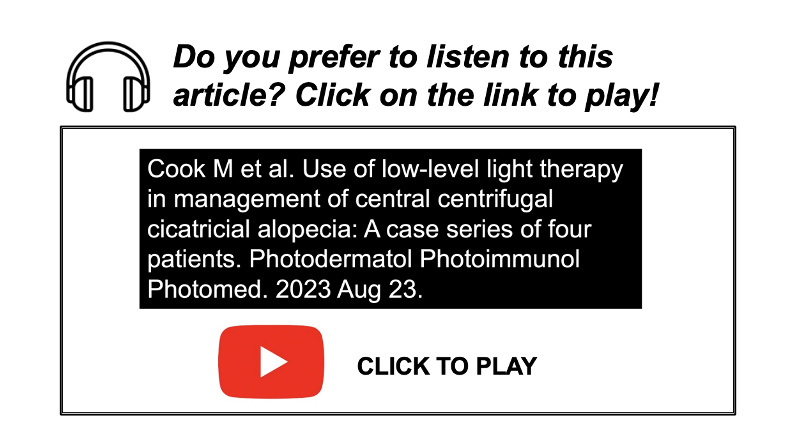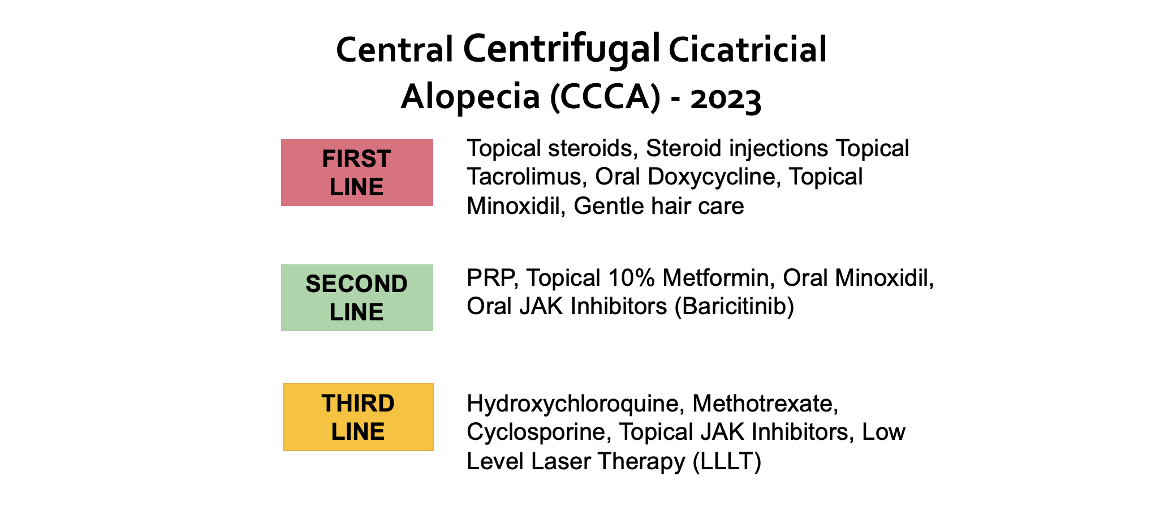Use of LED laser therapy in CCCA
LLLT Is A Treatment Option Worth Researching Further in CCCA
Download PDF Version of Article
CCCA is a scarring alopecia that more commonly affects black women. Typical first line treatment options include topical steroids, steroid injections, doxycycline, tacrolimus, minoxidil and gentle hair care practices.
These do not help all patients and new research is uncovering additional treatments that may have benefit. These additional treatments may include topical 10 % metformin and oral baricitinib.
Here a new study reports on the use of LED light therapy.
Cook et al 2023
A new study examined the use of low level laser therapy in five African American women with a biopsy-proven diagnosis of stage 2–4 CCCA. This was a prospective clinical trial. Four patients ultimately completed the trial and one was lost to follow up.
CCCA is graded on a scale of 0 to 5. The grade 0 suggests normal hair density and grade 5 suggestive of severe alopecia
In this study, all patients were required to be on a stable treatment regimen for at least 3 months prior to enrollment, and other treatment regimens were kept constant throughout the study period. Each patient was instructed to use the REVIAN RED all- LED Light Cap for 10 min per day. The REVIAN RED cap (REVIAN Inc) used in the study contains 119 light-emitting diodes (LEDs) on the cap's interior surface and these emit both orange (620 nm) and red (660 nm) light.
In the trial, patients' hair loss was assessed at the beginning and with follow-up visits at 2, 4, and 6 months. Assessment techniques included use of digital photography, patient self-assessments of symptoms, dermoscopic assessment, and clinician evaluations of severity .
Results
As mentioned, four patients ultimately completed the trial and one was lost to follow up. Patient ages ranged from 49-69. Patients were 49, 50, 61 and 60. Mean age was 57.2 years old.. Patients were black or African American. Hair loss was stage 2b in two patients, stage 3b in one patient and stage 4A in one patient. Patients had a disease duration ranging from 10 to 22 years (i.e. 10 , 15, 19 and 22 years). The average duration of disease was 16.5 years.
All patients were concurrently treated with topical steroids and topical minoxidil. Two were receiving steroid injections. One had doxycycline and one had finasteride.
The authors monitored perifollicular scale, hyperpigmentation, breakage, interfollicular scale, erythema, loss of follicular openings and photos.
At a 6 months follow up visit, laser therapy had no effect on redness, interfollicular or perifollicular scale or hyperpigmentation. It helped one patient improve breakage from moderate to mild but did not help hair breakage in 3 others.
The biggest effect was on loss of follicular openings where it helped 3 of 4 patients. In 2 of the patients, the loss went from moderate loss of follicular openings to mild and in one it went from severe loss of follicular openings to mild.
After 6 months of treatment, n increase in the global appearance of hair density was observed via digital photography in three of four (75%) patients.
Two patients had a reduction in itching.
The patient with the most severe disease stage at base- line had no increased hair loss noted via digital photography following 6 months of treatment which could be due to the advanced progression of her disease
There were no side effects that were reported.
Comments
I liked this study. It’s one of the first studies on the use of LED light for CCCA management.
I noted there that the period of stability before starting the study was not long enough. The study required patients to be on a stable regimen for just three months. Ideally that needs to be 6 or 9 months in CCCA as treatments like doxycycline, topical minoxidil topical steroids and finasteride theoretically could have explained all the nice results in this study.
Nevertheless it’s an important start. I think it’s worthwhile for us to continue to explore the use of lasers in CCCCA.
Adherence was high in this study and patients were committed to using the laser. (at least 4 of the 5 were). It is important to note that laser therapy suffers from a fatigue factor over time so one wonders about long term results. Lots and lots of lasers in the world are currently sitting in closets so not everyone loves there laser after a while and some forget they even own one.
In this study, Revian company provided that caps free. This may or may not be representative of the real world where people don’t’ have free caps and aren’t in a clinical study. Real world data is always important.
Second, it’s nice to see that one of the patients in the study was on doxycycline and did fine with no interaction between light and doxycycline. We have numerous patients with various types of scarring alopecia on doxycycline and laser therapy and we don’t see a problem. Good studies have not been done but it’s mostly UV radiation that creatives a problem with doxycycline and not red light laser.
Third, we don’t know if other red light type lasers would have similar effect. There’s no real reason to believe they would not but this was a sponsored study of the REVIAN laser. The Revian is a laser with both orange and red light.
REFERENCE
Cook M et al. Use of low-level light therapy in management of central centrifugal cicatricial alopecia: A case series of four patients. Photodermatol Photoimmunol Photomed. 2023 Aug 23.
This article was written by Dr. Jeff Donovan, a Canadian and US board certified dermatologist specializing exclusively in hair loss.


